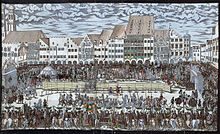Old landscape building
The old landscape building was a former public building on Marienplatz in Munich .
History of the building
In the historical and original context, landscape means the totality of the estates in a medieval and early modern state in the sense of the estate order . The building served as the seat of the Bavarian state estates; it had grown together from three individual houses since the beginning of the 16th century. In 1733 the estates acquired the town house on the right next to the old landscape building built after 1565 and had it rebuilt from scratch. The entire facade, both the old and the new part, received a uniform, symmetrically designed stucco facade decoration. The town mason Johann Georg Ettenhofer was involvedin the execution.
From 1808 to 1863 the government of the Isar district or Upper Bavaria was located here . The state estates had moved into the new landscape building since the end of the 18th century .
In 1865/67 the entire building was demolished to make room for the first construction phase of the New Town Hall . Some fittings were sold in 1865. The government had previously been relocated to the new building on Maximilianstrasse. The Landschaftsstraße at Marienhof behind the New Town Hall is still a reminder of the former meeting place of the state estates.
Land estates in Bavaria
The estates are the representations (estates corporations) in the territories of the Roman German Empire . Until 1550 the estates met every two years, until 1580 every three, until 1612 only every four years. The state parliament was then suspended. In the 17th century, with the Thirty Years' War and the growing power of the sovereign principality (according to the ideas of absolutism ) the decline of the estates began in Bavaria as well. In 1669 the state parliament was convened again and for the last time. The decline in importance of the estates continued in the 18th century. Nevertheless, the effectiveness of the estates was not abolished in the 18th century. Instead of the state parliaments, the corporate bodies with their administrations now monitored state activities and ensured orderly finances.
Web links
- Historical lexicon of Bavaria, estates
- Bavarian estates and the development of the early modern state in the 16th century
literature
- Karl Erdmannsdorffer: The community center in Munich. 1972, ISBN 380300019X , p. 83.
Coordinates: 48 ° 8 ′ 15 " N , 11 ° 34 ′ 33" E



